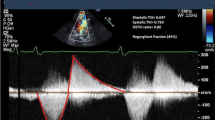Summary
Few data exist which address the significance of the Doppler gradient across a residual narrowing in older children who have had a coarctation repaired. Therefore, we evaluated 11 patients with repaired aortic coarctation with and without residual obstruction by Doppler echocardiography. The Doppler-derived transcoarctation pressure gradient correlated poorly with catheter-measured peak-to-peak and catheter maximal instantaneous gradients when only the maximal velocity across the repair was utilized in the simplified Bernoulli equation, [r=0.73, standard of error of the estimate (SEE)=5.0 mmHg andr=0.56, SEE=7.6 mmHg, respectively]. However, when the precoarctation velocity was included in the simplified Bernoulli equation, the correlation between Doppler-derived and catheter-measured gradients became excellent. The maximal Doppler gradient correlated well with catheter peak-to-peak gradient (r=0.95, SEE=2.2 mmHg) and catheter maximal instantaneous gradient (r=0.94, SEE=3.2 mmHg). However, the maximal Doppler gradient slightly overestimated the catheter peak-to-peak gradient and underestimated the catheter maximal instantaneous gradient. The Doppler mean gradient showed excellent correlation with the catheter mean gradient (r=0.97, SEE=0.85 mmHg). Precoarctation velocities were generally twofold greater than published normals due to a spatial acceleration phenomenon. All subjects had residual hypoplasia of the transverse aorta such that its transverse diameter was 29% less than, and its crosssectional area was 50% less than, the ascending and descending aorta. Thus, it is apparent that proximal velocities must be accounted for in the modified Bernoulli equation in order to achieve an accurate gradient determination, and that this gradient is representative of a value that is between the maximal instantaneous and peak-to-peak catheter gradient. Flow acceleration within the transverse aorta may be related to significant reductions in luminal radius and crosssectional area.
Similar content being viewed by others
References
Fyfe DA, Currie PH, Seward JB, et al. (1984) Continuous-wave Doppler determination of the pressure gradient across pulmonary artery bands: hemodynamic correlation in 20 patients.Mayo Clin Proc 59:744
George B, DiSessa TG, Williams R, Friedman WF, Laks H (1987) Coarctation repair without cardiac catheterization in infants.Am Heart J 114:1421–1425
George L, Walkman JD, Kirkpatrick SE, Turner SW, Pappelbaum SJ (1982) Two-dimensional echocardiographic visualization of the aortic arch by right parasternal scanning in neonates and infants.Pediatr Cardiol 2:227–280
Grenadier E, Lima CO, Allen HD, Sahn DJ, Vargas-Barron J, Valdes-Cruz LM, Goldberg SJ (1984) Normal intracardiac and great vessel Doppler flow velocities in infants and children.J Am Coll Cardiol 4:343–350
Houston AB, Simpson IA, Pollock JCS, Jamieson MPG, Doig WB, Coleman EN (1987) Doppler ultrasound in the assessment of severity of coarctation of the aorta and interruption of the aortic arch.Br Heart J 57:38–43
Huhta HC, Latson LA, Gutgesell HP, Cooley DA, Kearney DL (1984) Echocardiography in the diagnosis and management of symptomatic aortic valve stenosis in infants.Circulation 70:438–444
Marx GR, Allen HD (1986) Accuracy and pitfalls of Doppler evaluation of the pressure gradient in aortic coarctation.J Am Coll Cardiol 7:1379–1385
Riggs TW, Berry TE, Aziz KU, Paul MH (1982) Two-dimensional echocardiographic features of interruption of the aortic arch.Am J Cardiol 50:1385–1390
Sanders SP, MacPherson D, Yeager SB (1986) Temporal flow velocity profile in the desending aorta in coarctation.J Am Coll Cardiol 7:603–609
Shaddy RE, Snider AR, Silverman NH, Lutin W (1986) Pulsed Doppler findings in patients with coarctation of the aorta.Circulation 73:82–88
Simpson IA, Sahn DJ, Valdes-Cruz LM, Chung KJ, Sherman FS, Swenson RE (1988) Color Doppler flow mapping in patients with coarctation of the aorta: new observations and improved evaluation with color flow diameter and proximal acceleration as predictors of severity.Circulation 77:736–744
Smallhorn JF, Huhta JS, Adams PA, Anderson RH, Wilkinson JI, Macartney FJ (1983) Cross-sectional echocardiographic assessment of coarctation in the sick neonate and infant.Br Heart J 50:349
Snider AR, Silverman NH (1981) Suprasternal notch echocardiography: a two-dimensional technique for evaluating congenital heart disease.Circulation 63:165–173
Stark J, Smallhorn J, Huhta J, Deleval M, Macartney F, Rees P, Taylor J (1983) Surgery for congenital heart defects diagnosed with cross-sectional echocardiography.Circulation 68:129–138
Wyse RKH, Robinson PJ, Deanfield JE, Redoe DS, Macartney FJ (1984) Use of continuous-wave Doppler ultrasound velocimetry to assess the severity of coarctation of the aorta by measurement of aortic flow velocities.Br Heart J 52:278–283
Author information
Authors and Affiliations
Rights and permissions
About this article
Cite this article
Aldousany, A.W., DiSessa, T.G., Alpert, B.S. et al. Significance of the Doppler-derived gradient across a residual aortic coarctation. Pediatr Cardiol 11, 8–14 (1990). https://doi.org/10.1007/BF02239541
Issue Date:
DOI: https://doi.org/10.1007/BF02239541




